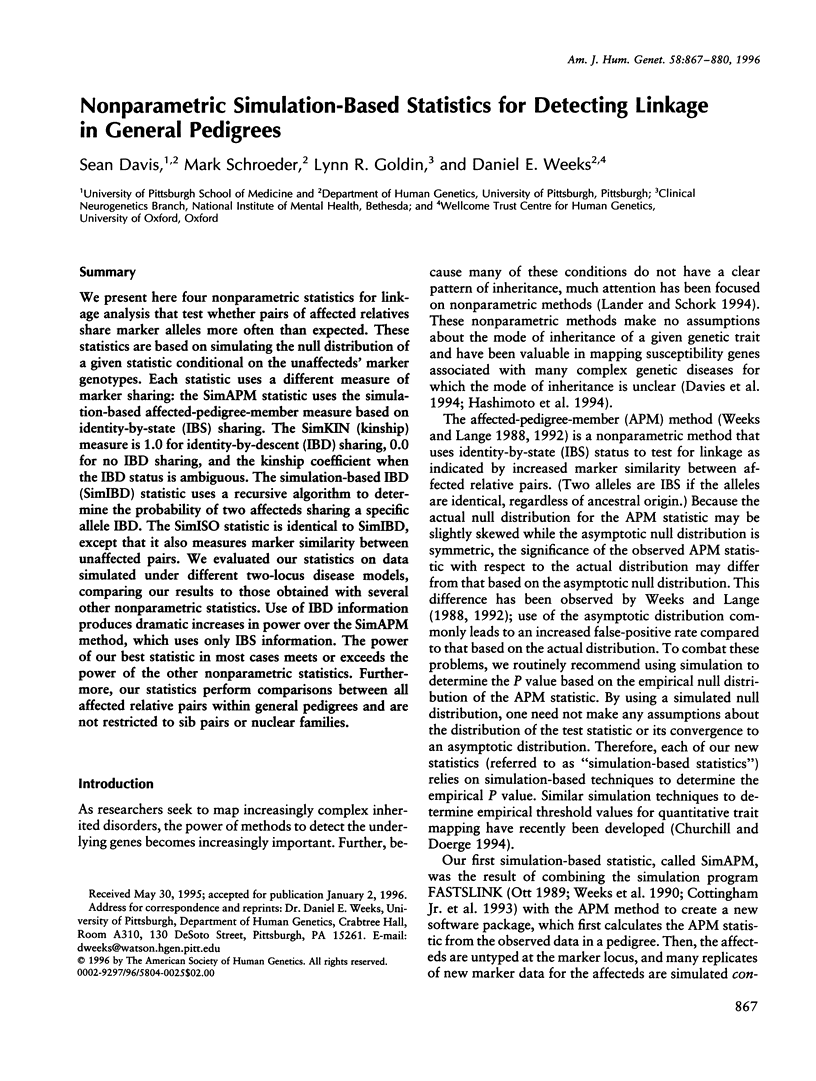Nonparametric simulation-based statistics for detecting linkage in general pedigrees (original) (raw)
. 1996 Apr;58(4):867–880.
Abstract
We present here four nonparametric statistics for linkage analysis that test whether pairs of affected relatives share marker alleles more often than expected. These statistics are based on simulating the null distribution of a given statistic conditional on the unaffecteds' marker genotypes. Each statistic uses a different measure of marker sharing: the SimAPM statistic uses the simulation-based affected-pedigree-member measure based on identity-by-state (IBS) sharing. The SimKIN (kinship) measure is 1.0 for identity-by-descent (IBD) sharing, 0.0 for no IBD status sharing, and the kinship coefficient when the IBD status is ambiguous. The simulation-based IBD (SimIBD) statistic uses a recursive algorithm to determine the probability of two affecteds sharing a specific allele IBD. The SimISO statistic is identical to SimIBD, except that it also measures marker similarity between unaffected pairs. We evaluated our statistics on data simulated under different two-locus disease models, comparing our results to those obtained with several other nonparametric statistics. Use of IBD information produces dramatic increases in power over the SimAPM method, which uses only IBS information. The power of our best statistic in most cases meets or exceeds the power of the other nonparametric statistics. Furthermore, our statistics perform comparisons between all affected relative pairs within general pedigrees and are not restricted to sib pairs or nuclear families.

Selected References
These references are in PubMed. This may not be the complete list of references from this article.
- Amos C. I., Dawson D. V., Elston R. C. The probabilistic determination of identity-by-descent sharing for pairs of relatives from pedigrees. Am J Hum Genet. 1990 Nov;47(5):842–853. [PMC free article] [PubMed] [Google Scholar]
- Amos C. I., Elston R. C., Wilson A. F., Bailey-Wilson J. E. A more powerful robust sib-pair test of linkage for quantitative traits. Genet Epidemiol. 1989;6(3):435–449. doi: 10.1002/gepi.1370060306. [DOI] [PubMed] [Google Scholar]
- Babron M. C., Martinez M., Bonaïti-Pellié C., Clerget-Darpoux F. Linkage detection by the Affected-Pedigree-Member method: what is really tested? Genet Epidemiol. 1993;10(6):389–394. doi: 10.1002/gepi.1370100610. [DOI] [PubMed] [Google Scholar]
- Churchill G. A., Doerge R. W. Empirical threshold values for quantitative trait mapping. Genetics. 1994 Nov;138(3):963–971. doi: 10.1093/genetics/138.3.963. [DOI] [PMC free article] [PubMed] [Google Scholar]
- Curtis D., Sham P. C. Using risk calculation to implement an extended relative pair analysis. Ann Hum Genet. 1994 May;58(Pt 2):151–162. doi: 10.1111/j.1469-1809.1994.tb01884.x. [DOI] [PubMed] [Google Scholar]
- Davies J. L., Kawaguchi Y., Bennett S. T., Copeman J. B., Cordell H. J., Pritchard L. E., Reed P. W., Gough S. C., Jenkins S. C., Palmer S. M. A genome-wide search for human type 1 diabetes susceptibility genes. Nature. 1994 Sep 8;371(6493):130–136. doi: 10.1038/371130a0. [DOI] [PubMed] [Google Scholar]
- Goldin L. R., Weeks D. E. Two-locus models of disease: comparison of likelihood and nonparametric linkage methods. Am J Hum Genet. 1993 Oct;53(4):908–915. [PMC free article] [PubMed] [Google Scholar]
- Haseman J. K., Elston R. C. The investigation of linkage between a quantitative trait and a marker locus. Behav Genet. 1972 Mar;2(1):3–19. doi: 10.1007/BF01066731. [DOI] [PubMed] [Google Scholar]
- Hashimoto L., Habita C., Beressi J. P., Delepine M., Besse C., Cambon-Thomsen A., Deschamps I., Rotter J. I., Djoulah S., James M. R. Genetic mapping of a susceptibility locus for insulin-dependent diabetes mellitus on chromosome 11q. Nature. 1994 Sep 8;371(6493):161–164. doi: 10.1038/371161a0. [DOI] [PubMed] [Google Scholar]
- Kong A., Frigge M., Irwin M., Cox N. Importance sampling. I. Computing multimodel p values in linkage analysis. Am J Hum Genet. 1992 Dec;51(6):1413–1429. [PMC free article] [PubMed] [Google Scholar]
- Lander E. S., Schork N. J. Genetic dissection of complex traits. Science. 1994 Sep 30;265(5181):2037–2048. doi: 10.1126/science.8091226. [DOI] [PubMed] [Google Scholar]
- Lange K., Goradia T. M. An algorithm for automatic genotype elimination. Am J Hum Genet. 1987 Mar;40(3):250–256. [PMC free article] [PubMed] [Google Scholar]
- Lange K., Matthysse S. Simulation of pedigree genotypes by random walks. Am J Hum Genet. 1989 Dec;45(6):959–970. [PMC free article] [PubMed] [Google Scholar]
- Lange K., Sobel E. A random walk method for computing genetic location scores. Am J Hum Genet. 1991 Dec;49(6):1320–1334. [PMC free article] [PubMed] [Google Scholar]
- Litt M., Kramer P., Browne D., Gancher S., Brunt E. R., Root D., Phromchotikul T., Dubay C. J., Nutt J. A gene for episodic ataxia/myokymia maps to chromosome 12p13. Am J Hum Genet. 1994 Oct;55(4):702–709. [PMC free article] [PubMed] [Google Scholar]
- Martinez M., Goldin L. R. Power of the linkage test for a heterogeneous disorder due to two independent inherited causes: a simulation study. Genet Epidemiol. 1990;7(3):219–230. doi: 10.1002/gepi.1370070306. [DOI] [PubMed] [Google Scholar]
- O'Connell J. R., Weeks D. E. The VITESSE algorithm for rapid exact multilocus linkage analysis via genotype set-recoding and fuzzy inheritance. Nat Genet. 1995 Dec;11(4):402–408. doi: 10.1038/ng1295-402. [DOI] [PubMed] [Google Scholar]
- Ott J. Computer-simulation methods in human linkage analysis. Proc Natl Acad Sci U S A. 1989 Jun;86(11):4175–4178. doi: 10.1073/pnas.86.11.4175. [DOI] [PMC free article] [PubMed] [Google Scholar]
- Risch N. Linkage strategies for genetically complex traits. III. The effect of marker polymorphism on analysis of affected relative pairs. Am J Hum Genet. 1990 Feb;46(2):242–253. [PMC free article] [PubMed] [Google Scholar]
- Van Eerdewegh P., Hampe C. L., Suarez B. K., Reich T. Alzheimer's disease: a piscatorial trek. Genet Epidemiol. 1993;10(6):395–400. doi: 10.1002/gepi.1370100611. [DOI] [PubMed] [Google Scholar]
- Ward P. J. Some developments on the affected-pedigree-member method of linkage analysis. Am J Hum Genet. 1993 Jun;52(6):1200–1215. [PMC free article] [PubMed] [Google Scholar]
- Weeks D. E., Lange K. The affected-pedigree-member method of linkage analysis. Am J Hum Genet. 1988 Feb;42(2):315–326. [PMC free article] [PubMed] [Google Scholar]
- Whittemore A. S., Halpern J. Probability of gene identity by descent: computation and applications. Biometrics. 1994 Mar;50(1):109–117. [PubMed] [Google Scholar]